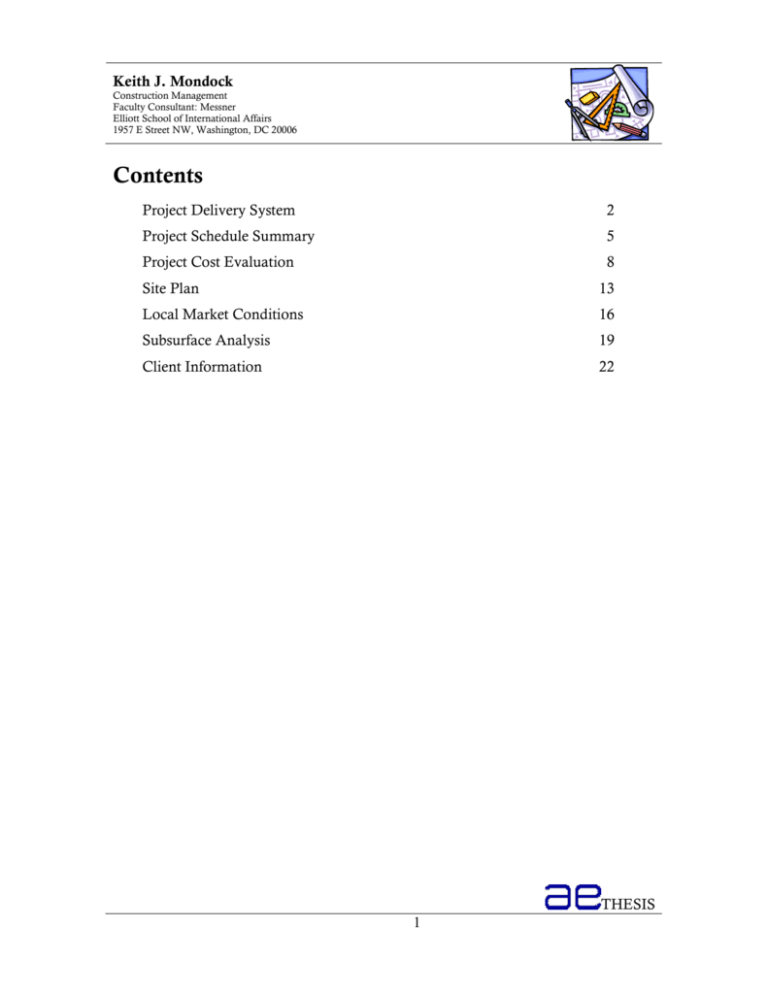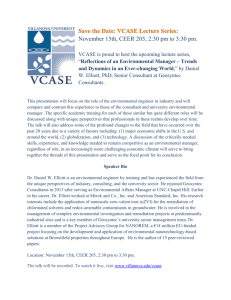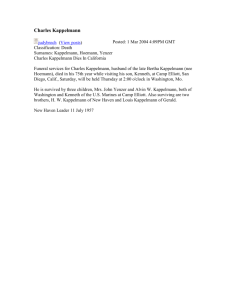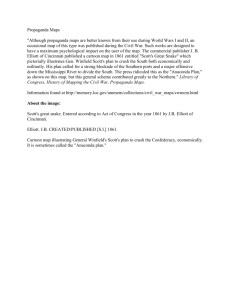Contents - College of Engineering
advertisement

Keith J. Mondock Construction Management Faculty Consultant: Messner Elliott School of International Affairs 1957 E Street NW, Washington, DC 20006 Contents Project Delivery System 2 Project Schedule Summary 5 Project Cost Evaluation 8 Site Plan 13 Local Market Conditions 16 Subsurface Analysis 19 Client Information 22 THESIS 1 Keith J. Mondock Construction Management Faculty Consultant: Messner Elliott School of International Affairs 1957 E Street NW, Washington, DC 20006 Project Delivery System Delivery System Organizational Chart THESIS 2 Keith J. Mondock Construction Management Faculty Consultant: Messner Elliott School of International Affairs 1957 E Street NW, Washington, DC 20006 Delivery System Description Owner – Construction Manager Arrangement For the construction of its Elliott School of International Affairs, the George Washington University hired the Gilbane Building Company to provide atrisk construction management services at a guaranteed maximum price (GMP). The GMP contract includes a percentage-based, profit sharing clause that requires Gilbane to return a portion of the money saved if the actual construction costs are less than the GMP bid. Owner – Architect Arrangement The George Washington University hired SmithGroup to perform the architectural design of the Elliott School. The University entered into a fixed fee agreement with SmithGroup for the design and construction consultation services. It was then the responsibility of SmithGroup to hire engineers and consultants to complete the design of the facility—HVAC design was handled in-house by the architect. Construction Manager – Construction Subcontractor Arrangement The Gilbane Building Company holds all construction subcontractor contracts for the Elliott School construction project. All construction subcontractor contracts are lump sum. The subcontractor contracts require that a minimum of 10% of each lump sum bid amount come from the involvement of a Minority Business Enterprise (MBE), Women Business Enterprise (WBE), or Small Business Enterprise (SBE) subcontractor or supplier. Participation in the D.C. First Source Agreement is also required of each subcontractor and supplier. THESIS 3 Keith J. Mondock Construction Management Faculty Consultant: Messner Elliott School of International Affairs 1957 E Street NW, Washington, DC 20006 Architect – Design Consultant Relationship To aid in the design of the Elliott School of International Affairs, SmithGroup established standard AIA Architect-Consultant Contracts with engineering and consulting firms. The contracts were modeled off the 1997 edition of AIA form #C142, with each consultant receiving a stipulated fee. The fee’s of each consultant were combined with that of SmithGroup for the architectural design and presented to the University as a single sum. Construction Manager – Design Team Relationship No formal contractual arrangement exists between the Gilbane Building Company and the Design Team—architects, engineering firms, and related consultants. There is, however, lines of communication exist between the construction manager and all design firms. Although all RFI’s and submittals are directly sent to SmithGroup and then distributed to the applicable design entity, informal communication exists between all parties—basic design questions and their relationship to the construction of the design documents are often posed via phone call or e-mail from Gilbane to nearly all of the design firms on a regular basis. THESIS 4 Keith J. Mondock Construction Management Faculty Consultant: Messner Elliott School of International Affairs 1957 E Street NW, Washington, DC 20006 Project Schedule Summary Overall Design and Construction Schedules The design of the Elliott School of International Affairs began in July of 1999 and continued for 16 months, ending in November of 2000. The work packages for excavation, sheeting and shoring, and foundation construction were released early, allowing construction to begin in October of 2000. The residential component of the Elliott School was turned over to the University on August 15, 2002 and the academic component is scheduled to be turned over on November 15, 2002. Construction is scheduled to last a total of 24.5 months. A Primavera summary schedule detailing the design and construction phases of the Elliott School of International Affairs project is included on page 7. Key Elements of Construction Sequencing Foundation - Large amount of excavation required for three levels of underground parking and one basement level - Foundation work to overlap excavation due to large building footprint and varying foundation types-- caissons, column footings, foundation footings, and strap beams Structure - Cast-in-place concrete superstructure comprised of post-tensioned concrete girders, concrete columns, and post tensioned concrete floor slabs - Large amount of formwork needed for cast-in-place system THESIS 5 Keith J. Mondock Construction Management Faculty Consultant: Messner Elliott School of International Affairs 1957 E Street NW, Washington, DC 20006 - MEP/Interior Subdivision rough-in work to overlap structure work— cast-in-place work to proceed upwards, MEP/Interior Subdivision work to follow after floors cured and shoring removed Finish - Finish work must follow building enclosure—roofing and curtain wall work—so that work is protected from the weather - Terrazzo flooring requires floor to be closed to construction during pour and cure period - Finish work of residential more repetitive and to smaller scale in residential component, leading to varying completion dates for the residential and academic portions THESIS 6 Keith J. Mondock Construction Management Faculty Consultant: Messner Elliott School of International Affairs 1957 E Street NW, Washington, DC 20006 THESIS 7 Keith J. Mondock Construction Management Faculty Consultant: Messner Elliott School of International Affairs 1957 E Street NW, Washington, DC 20006 Project Cost Evaluation Construction Costs Actual Building Construction Cost (CC) Construction Const/Square Foot (CC/SF) $53,984,092.00 $162.97 /SF Total Project Costs Total Project Cost includes construction, design, and land costs. Construction costs total $53,984,092. Design costs for the Elliott School were approximately $19 million. Land costs do not apply since the project is being constructed on land previously owned by the George Washington University. Approximate Total Project Cost: $73,000,000.00 Major Building Systems Costs Structural System Cost $11,005,700.00 Structural System Cost/SF Mechanical/Plumbing System Cost Mechanical/Plumbing System Cost/SF Electrical System Cost Electrical System Cost/SF Fire Protection System Cost Fire Protection System Cost/SF $33.23 /SF $7,016,500.00 $21.18 /SF $5,570,000.00 $16.82 /SF $461,900.00 $1.39 /SF Design Costs Total Design Costs for the Elliot School of International Affairs were approximated to be $19 million by Frank Menendez, SmithGroup Project Manager. THESIS 8 Keith J. Mondock Construction Management Faculty Consultant: Messner Elliott School of International Affairs 1957 E Street NW, Washington, DC 20006 D4 Cost 2002 Parametric Estimate For the D4 Parametric Estimate the Elliot School of International Affairs was estimated as three separate structures—an academic classroom/office facility, student housing structure, and a subterranean parking garage. The academic classroom/office facility was compared to a pair of projects in the D4 database, both of which were concrete structures constructed on urban sites. The academic facility estimate provided $18,155,611 in costs when averaged, adjusted, and rebased using D4 software. The student housing structure was based on a similar university project. The student housing structure adds $9,175,086 when adjusted using D4. The parking garage estimate of $2,456,168 came from a comparison to a similar underground parking structure. Applicable D4 Print-Outs are included in the pages following the Project Cost Evaluation Section. Total D4 Parametric Estimate: $29,786,865.00 RS Means SF Estimate A square foot estimate was produced using the 2002 RS Means Square Foot Cost Index. Three separate buildings were analyzed and summed to produce the total SF Estimate—a college dormitory, a college classroom building, and an underground parking garage. Building costs were adjusted using the historical cost indexes (as bids went out and construction began in 2000) and the location factor for Washington, DC. THESIS 9 Keith J. Mondock Construction Management Faculty Consultant: Messner Elliott School of International Affairs 1957 E Street NW, Washington, DC 20006 Calculations: - College Dormitory $112.83 -$3.39(1.67) -$1.19(3) $103.60 Base SF cost—through interpolation LF building perimeter adjustment Story height adjustment Final SF cost $103.60/SF x 70,784 = $7,333,222.40 - College Classroom Building $105.96 -$.75(1.45) +$.51(4) $106.91 Base SF cost—through interpolation LF building perimeter adjustment Story height adjustment Final SF cost $106.91/SF X 140,067 = $14,974,562.97 - Underground Parking Garage $49.76 -$.72(1) $49.04 Base SF cost—through interpolation No LF building perimeter adjustment needed Story height adjustment Final SF cost $49.04/SF X 90,245 = $4,425,614.80 - Summed Building Cost $7,333,222.40 +$14,974,562.97 +$4,425,614.80 $26,733,400.17 College Dormitory College Classroom Building Underground Parking Garage Summed Building Cost - Final Building Cost $26,733,400.17 x 113.8/118.9 x .95 $24,307,383.45 Summed Building Cost 2000/2002 DC Historical Cost Indexes Washington, DC Location Factor Final Building Cost THESIS 10 Keith J. Mondock Construction Management Faculty Consultant: Messner Elliott School of International Affairs 1957 E Street NW, Washington, DC 20006 Total RS Means SF Cost Estimate: $24,307,383.45 Project Cost Evaluation Discussion Cost Comparison: $53,984,092.00 $29,786,865.00 $24,307,383.45 Actual Construction Cost D4 Parametric Estimate RS Means SF Estimate Cost estimates varied greatly from the actual cost of construction for the Elliott School of International Affairs. The Parametric and SF Estimates were each performed for three separate building types and then combined at the end to produce a final building estimate due to the varying uses of the Elliott School’s spaces—academic classroom and offices, student housing, and an underground parking garage. Separating the building into three individual structures for estimating purposes led to much of the large difference in cost. The foundation and structural systems were invariably undersized as the estimates failed to account for the stacking of the different building types. Also, the high level of interior and exterior finishes of the Elliott School was not represented in the estimates performed. Differences are evident in the D4 estimate and the actual construction costs because of the lack of projects consistent with the Elliott School in structural component, size, and use in the D4 database. Differences are evident in the RS Means estimate and the actual construction costs because of the lack of consistent projects in the RS Means SF Cost Index. Means contains data for 4-8 story dormitories, however the Elliott School rises eleven stories above the street for its residential component. College Classroom Buildings contained in Means are for just 2-3 stories, yet the Elliott School’s academic component contains eight stories of classrooms THESIS 11 Keith J. Mondock Construction Management Faculty Consultant: Messner Elliott School of International Affairs 1957 E Street NW, Washington, DC 20006 and offices. Also, the exterior wall types of those buildings estimated utilizing Means were not consistent with that of the Elliott School. The cost of granite and a metal and glass curtain wall would surely exceed that of precast concrete panels or face brick. When considering the differences in the buildings used in the comparative estimates to the Elliot School of International Affairs, it would be expected that the estimated costs would fall well below the actual cost of construction. THESIS 12 Keith J. Mondock Construction Management Faculty Consultant: Messner Elliott School of International Affairs 1957 E Street NW, Washington, DC 20006 Site Plan – Concrete Erection Project Fence The Elliott School of International Affairs construction site was completely surrounded by an eight foot construction fence during concrete erection and throughout construction. The applicable permits were acquired to extend the fence into the parking lanes of 19th Street and E Street along the site extents. Access and egress for material delivery to the site were made along 19th Street and E Street. The sidewalks along 19th and E Streets were closed to foot traffic and signs directed pedestrians to use sidewalks along the other sides of the streets. Permits could not be obtained to close the sidewalk or to provide entrance and egress to the site along 20th Street—the adjacent American Red Cross Headquarters construction project had previously obtained permits for the parking lane and sidewalk opposite the Elliott School. Site Trailers Throughout the erection of the cast-in-place structure, the Gilbane Building Company maintained a site trailer at the corner of 20th and E Streets. Subcontractor trailers were located along the southeast corner of the site at the intersection of 19th and E Streets. Material Storage Material and formwork necessary for concrete erection were located along the eastern and southern site fences. The parking lane of 19th and E Streets were closed to traffic allowing delivery trucks to easily access the site and temporarily park as material was unloaded. THESIS 13 Keith J. Mondock Construction Management Faculty Consultant: Messner Elliott School of International Affairs 1957 E Street NW, Washington, DC 20006 Temporary Utilities Temporary power was supplied to the site at three locations. At the northwest and north central site extents, temporary Potomac Electric Power Company (PEPCO) feeds were established to service the construction process. At the southeast corner of the site, a PEPCO feed supplied power to the construction site trailers as well as the construction process. Water was supplied to the construction process along the western site border. An eight-inch water main running below 20th Street supplied water to the construction process and ultimately provided final water service to the building. Tower Cranes A pair of tower cranes were utilized for the erection of the cast-in-place structural system for the Elliott School. One crane was positioned to construct the eastern half of the building, while a second was positioned to construct the western half. Construction progressed from the east to the west; therefore the western crane was erected one week prior to and dismantled three weeks before the eastern crane. Material Hoist A material hoist was established near the southeast corner of the Elliott School Building during concrete erection and maintained for nearly the remainder of construction. Following the completion of concrete erection, a second material hoist was installed at the buildings southwest corner. Both hoists were serviced by loading docks. THESIS 14 Keith J. Mondock Construction Management Faculty Consultant: Messner Elliott School of International Affairs 1957 E Street NW, Washington, DC 20006 SITE PLAN DRAWING THESIS 15 Keith J. Mondock Construction Management Faculty Consultant: Messner Elliott School of International Affairs 1957 E Street NW, Washington, DC 20006 Local Market Conditions Labor Market Conditions Construction projects within the District of Columbia have a seemingly endless supply of labor; however with the large number of major construction projects currently underway, the availability of skilled labor is dwindling. The requirements of the project have exceeded some of the contractors available labor resources, forcing the open-shop contractors to turn to labor rental companies to supply skilled tradesmen. Contractors for the Elliott School construction project come from as far away as northern Maryland, making more than an hour and a half commute to Washington, DC each day. Union Considerations The Gilbane Building Company, at-risk construction managers for the Elliott School of International affairs project, maintains a company tendency of contracting work only with open-shop contractors. As a result, the contractors on the Elliott School project were contracted without regard to their union or non-union status. Solely employing open-shop contractors has led to a large number of rental workers from companies such as Tradesmen International and Labor Ready performing work on the Elliott School. Workers from labor rental companies are not affiliated with, nor have gone through the training of the contractors for which they perform work. Workers are hired from rental companies when a project’s labor requirements exceed a contractor’s own work force. Open-shop contractors do not have the ability to hire workers through a union hall, and therefore often turn to labor rental companies for additional skilled labor. THESIS 16 Keith J. Mondock Construction Management Faculty Consultant: Messner Elliott School of International Affairs 1957 E Street NW, Washington, DC 20006 Concurrent Construction Numerous construction projects are progressing concurrently with the Elliott School project in downtown Washington, DC and the surrounding area. The Pentagon Renovation, Springfield Interchange project, construction of the American Red Cross Headquarters, and the demolition and construction of corporate offices for PEPCO are a sampling of the major projects occurring concurrently to the Elliott School. The 750,000 SF American Red Cross Headquarters is being built across 20th Street from and on a schedule that nearly mirrors that of the Elliott School. Sharing 20th Street with another major construction has caused the Elliott School project some difficulty. Gilbane was unable to obtain a permit to utilize the easternmost lane of 20th Street along the Elliott School site border for construction parking or material lay-down because the Red Cross Headquarters construction project team had previously obtained a permit for the westernmost lane. Preferred Method of Construction Within the Washington, DC beltway a height limit of 13-stories has led the preferred method of construction for large scale projects to historically be cast-inplace concrete. Outside the beltway, with no limit to building height, the tendency of construction projects has begun to shift toward structural steel. The Elliott School of International Affairs sits on the entire 1900 block of E Street in the heart of northwest Washington, DC. Its construction of cast-in-place concrete coincides with the preferred method of the downtown area. Construction Parking Although parking on site was limited, numerous parking facilities are available in the immediate vicinity of the Elliott School of International Affairs construction project. On site parking is limited to vehicles necessary for construction THESIS 17 Keith J. Mondock Construction Management Faculty Consultant: Messner Elliott School of International Affairs 1957 E Street NW, Washington, DC 20006 or the delivery or installation of materials or equipment. All other parking must be off site. The Gilbane Building Company, project construction managers, was able to acquire a level of a George Washington University operated parking garage just to the north of the Elliott School, but on the same block of 20th Street. The level of parking is utilized for on site staff and visitor parking. Between the University operated garage and the Elliott School sits a privately operated parking garage. The seven-story garage offers week and month long parking passes and is used by the vast majority of workers for parking during the work day. Recycling and Tipping Fees Two construction waste dumpsters were maintained through the finish work of the Elliott School project. At the peak of the finish process, sixteen dumpsters were pulled from the site in a single six day work week. Dumpster tipping fees for the project are $315 per pull. The contractors performing work on the Elliott School of International Affairs project did not recycle construction material waste. THESIS 18 Keith J. Mondock Construction Management Faculty Consultant: Messner Elliott School of International Affairs 1957 E Street NW, Washington, DC 20006 Subsurface Analysis Scope of Excavation With four below grade levels in the Elliott School of International Affairs construction project, the lowest floor level sitting nearly 46 feet below grade, substantial excavation was required over the buildings entire footprint. The total amount of soil removed was estimated to be 2900 cubic yards. Prior to excavation it was required that existing utilities be relocated and that trees outside the extents of excavation be protected. Soil Conditions At the request of SmithGroup, Schnabel Engineering Associates compiled a geotechnical engineering report for the Elliott School of International Affairs project. The subsurface conditions of the site were presented through an analysis of six boring samples. One soil test boring was performed in May of 1999, while the other five were from a previous soil analysis performed in 1977. The soil borings at the site indicated that firm to compact natural terrace soils will be present at the lowest floor slab, leading the geotechnical report to propose spread footing foundations as suitable for the support of the structure. The findings of the generalized soil strata are summarized in a table on page 19. The test borings also revealed ground water 43 feet below grade, requiring dewatering since the lowest floor level sits 46 feet below grade. Geotechnical Engineering Report The geotechnical engineering report performed by Schnabel Engineering Associates for the Elliott School construction project was not provided to the contractors for bidding. However the report was made available for review at the office of the architect, SmithGroup, throughout the bid period. As stated in the THESIS 19 Keith J. Mondock Construction Management Faculty Consultant: Messner Elliott School of International Affairs 1957 E Street NW, Washington, DC 20006 specifications, the geotechnical report was prepared solely for SmithGroup; therefore it is not considered a contract document and is to be used only for informational purposes. The specifications also state that if that data contained Schnabel’s geotechnical report is not considered to be adequate, the contractor is permitted to perform their own investigation, tests, and analyses, but at no cost to the owner, the George Washington University. Differing Site Conditions Clause Although the Schnabel Engineering Associate’s geotechnical engineering report submitted to SmithGroup suggested that “an allowance …be established to account for possible additional costs that may be required for the construction as recommended…,” a Differing Site Conditions (DSC) clause was not included in Gilbane Building Company’s contract with National Wrecking, the contractor hired to perform excavation and site work. Although a specific DSC clause was not included in the contract, exclusions were made for rock and contaminated soil; however none were encountered to significantly impact construction progress. Soil Retention Sheeting and shoring was required for the support of the excavation required for the Elliott School of International Affairs construction project. The sheeting system consisted of H beams, wood lagging, and bracing. Tiebacks were used to provide the sheeting system with lateral support. Where the tiebacks penetrated into public space, permits were required. Permission was obtained from owner of private properties into which tiebacks penetrated. On the north side of the site, the existing dormitory and parking garage had to be underpinned 5 feet below the lowest excavation grade. Bracket piles designed for 40 ton capacity were utilized for underpinning. THESIS 20 Keith J. Mondock Construction Management Faculty Consultant: Messner Elliott School of International Affairs 1957 E Street NW, Washington, DC 20006 Soil Conditions Summary Schedule Stratum A-Asphalt B-Fill C-Terrace D-Terrace E-Residual F-Rock Location From ground surface to depths of 0.7 feet From ground surface and below Stratum A to depths of 5 feet Below Stratum B to depths of 14 to 25 feet Below Stratum C to depths of 80 to 94 feet Below Stratum D about 3 to 7 feet thick Below Stratum E to 105.5 feet, the maximum depth sampled Soil Types Contained Asphalt Compaction Not applicable Brown and gray silty sand; gravel fill; probable fill including clay, concrete, cinders, wood, steel, and brick fragments Brown and gray sandy lean clay with layers of brown well and poorly graded sand and silty sand Poorly graded gravel; clayey sand and silty sand with layers of clay and boulders Gray disintegrated rock Generally loose Garnett gneiss rock Slightly to moderately fractured Generally medium stiff and firm Generally very compact Hard THESIS 21 Keith J. Mondock Construction Management Faculty Consultant: Messner Elliott School of International Affairs 1957 E Street NW, Washington, DC 20006 Client Information Description of the Owner The George Washington University owns and operates the Elliott School of International Affairs on its downtown Washington, DC campus. The George Washington University, founded in 1821 by the US Congress, currently is the largest university in the nation’s capitol with nearly 18,000 students. The Elliott School prepares students for an extensive range of international affairs careers in the business, nonprofit and governmental sectors. More than 1,000 undergraduate and 500 graduate students are currently pursuing an interdisciplinary liberal arts education from the Elliott School. 104 full time faculty are employed by the Elliott School. Construction Reasoning The George Washington University is constructing the 331,243 GSF building to expand the Elliott School into “one of the best schools of international affairs in the world,” according to Elliott School Dean Harry Harding. The Elliott School building will allow the Department of International Affairs to house under one roof their scholarly centers, research and policy programs, student services staff, administrative offices, along with their continuously growing faculty. Currently, the Elliott School occupies two campus buildings and combining the academic and office facilities of the school into a single building will better unify the program. The new facility also provides the School of International Affairs with larger, better-equipped classrooms and a state-of-the-art Commons with more space for public programs and private events. Dean Harding explains how the Elliott School’s growth in recent years necessitated construction, “These new facilities will provide THESIS 22 Keith J. Mondock Construction Management Faculty Consultant: Messner Elliott School of International Affairs 1957 E Street NW, Washington, DC 20006 us with more space to house our growing faculty, research programs, and outreach activities.” The Elliott School building combines the academic and office facilities with on-campus housing. The residential component is part of a campus-wide plan to increase housing capacity. According to zoning regulations, GW is required to house at least 70 percent of undergraduate students on campus by 2009. Owner’s Expectations The George Washington University sought construction on schedule and within the established budget for the Elliott School of International Affairs. The University monitored the construction progress by regularly meeting with the construction and design teams. Each week representatives from the University’s construction department attended progress meetings with Gilbane’s on-site construction management staff and representatives from SmithGroup, the project’s architects, and many of the other design firms. At each meeting the Gilbane presented progress and cost updates. Construction progress was compared to the initial and updated schedules prepared for the project. Costs were reported and compared to those projected, while construction changes were discussed and evaluated. Sequencing Issues and Occupancy Requirements Initial construction schedules indicated completion of construction of both the residential and academic components in August 2002. The George Washington University made living in the residential component of the Elliott School of International Affairs—described as 1957 E Street, the building’s address—an option for students for the 2002-2003 academic year in the spring of 2002. The University, however, maintained the existing academic facilities for the Elliott School for the THESIS 23 Keith J. Mondock Construction Management Faculty Consultant: Messner Elliott School of International Affairs 1957 E Street NW, Washington, DC 20006 Fall 2002 semester and does not plan to use the new offices and classrooms until the Spring 2003 semester. The residential component was turned over to the University on August 15, 2002, allowing students to move into their residences on schedule, while construction continued on the academic portion of the structure. Continuing construction while students occupy more than 20% of the building’s square foot area required construction of the residential component to proceed ahead of that for the academic component. Finish work—final painting, carpet installation, and appliance delivery—occurred throughout the residential component while electrical and HVAC rough-in progressed on the upper floors of the academic component. THESIS 24






